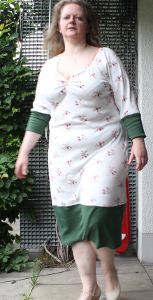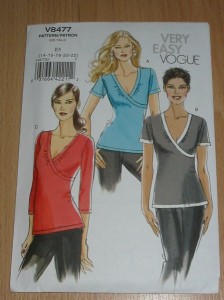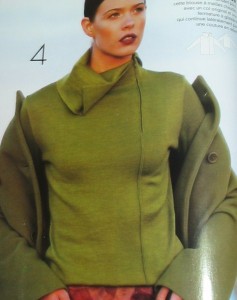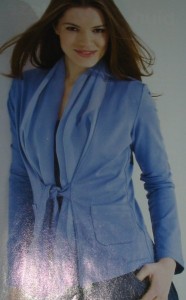Positively surprised
Vor einigen Jahren habe ich mir ja mal ein Kleid aus einer Knip als Nachthemd genäht. Das Ergebnis war „bettauglich“ aber mehr auch nicht.
Some years ago I’d used a pattern from Knip to make a night shirt. The result was good to wear in bed, but nothing more.
Jetzt war aber dringend ein neues Nachthemd nötig, also holte ich den Schnitt noch mal raus, denn er war immerhin schnell gegangen…
Now I quite urgently needed new nightwear, so I picked the old pattern again since it was something to make fast…
 Diesmal hat es sogar Ähnlichkeit mit einem Kleid! (Deswegen habe ich für das Photo dann auch richtige Schuhe angezogen. Den doofen Blick bitte ich zu entschuldigen….)
Diesmal hat es sogar Ähnlichkeit mit einem Kleid! (Deswegen habe ich für das Photo dann auch richtige Schuhe angezogen. Den doofen Blick bitte ich zu entschuldigen….)
This time it even comes close to a dress! (So I wore shoes for the photo. Please excuse the extremely stupid look…)
Mein Stoff hat diesmal etwas mehr Stand, es ist ein Rippenstrick aus Baumwolle, eher schon feiner Strick als noch Jersey. (Auch so eine Internettausch… entweder sah das Muster auf dem Bild völlig anders aus oder er stammt noch aus einer Zeit, als man sich oft auf Beschreibungen verlassen mußte, weil noch nicht jeder eine Digicam hatte.) Da das Material absolut nicht reichte, half Frau mhs mit einer farblich hervorragend passenden Schlauchware aus ihren Vorräten aus. Die Saumblende ist gut doppelt so breit wie die Anleitung vorgibt, die Ärmel sind etwa 5cm kürzer. Halb versehentlich, weil ich dachte, die Linie auf dem Schnitt wäre die Stelle, wo dann die Manschetten noch mal extra abgepaust werden mußten. Als ich die Manschetten dann annähen wollte, stellte ich fest, daß der Ärmel an der Stelle deutlich breiter ist, als er sollte. Was zu dem Schluß führte, daß die Linie nur vom Anstückeln auf dem Schnittbogen kam. Andererseits hätte der helle Stoff höchstens noch zwei Zentimeter mehr hergegeben….
This time my fabric is a cotton rib knit that is a bit firmer than the last fabric I had. (Another internet swap which was not as expected. Either it looked very differently from the pic or it was so long aog, that you had to rely on descriptions, because many people did not have a digital camera.) The fabric was not enough, but Frau mhs had the perfect green cotton jersey in her collection. I made the green part at the skirt about twice as larger as the pattern indicates it. The sleenes were shortened by 5 cm. Halfway accidentially. There was a line on the sleeve pattern and I thought that had been the line up to which the extra cuff part was supposed to be cut off. But when I tried to sew the cuff to the sleeve it turned out the sleeve was wider than expected. So the line on the pattern was from the piecing on the original pattern sheet. But anyhow, I could have maybe added 2cm more, but the fabric was definitely not enough for the original length.
Ich habe die Verarbeitung noch ein wenig schneller gestaltet: Statt für de Raffung einen Tunnel aufzunähen und ein Zugband einzuziehen, habe ich den Stoff gleich gerafft und mit einem Band drauf so fixiert. Das Ausmaß der Raffung habe ich beim Tragen an Version 1 abgemessen. (Zuerst wollte ich es auf einen Gummi nähen und dadurch raffen, aber sogar Unterbrustband vom BH nähen war nicht stark genug, für eine so starke Raffung.) Und die obere Kante habe ich mit Falzgummi eingefasst, dabei den Gummi 10 Prozent kürzer zugeschnitten als die Länge des Ausschnitts, hinten am Ausschnitt nur minimal gedehnt aufgenäht und den Rest der Dehnung dann seitlich und vorne verteilt. Dadurch sitzt der Ausschnitt viel besser.
I streamlined the sewing process a bit. Instead of sewing a fabric tunnel and making drawstrings into it I gathered the fabric at the front and sewed a ribbon over it to make the gathering stay. How much I wanted the gathers I could take from the first version. (First I had intended to sew it on a stretched piece of elastic to get the gathering, but not even the under bust elasting from bra sewing was strong enough for so much gathering.) For the neckline I used fold over elastic. I cut it 10 percent smaller than the neckline circumference, stretched it minamally while sewing it to the back neckline and distributed the rest evenly over sides and front. Now the neckline sits nicely.
 Das einzige was mich jetzt noch wirklich stört, ist daß die vordere Mitte am Ausschnitt nicht schön ist. Das ist ja ein gerades Stück Stoff, was sich dann in einen V-Ausschnitt legen soll. Das tut es natürlich nicht. Aber wenn man da ein kleines Eck abnäht…. könnte aus dem passenden Stoff vielleicht doch mal noch ein Kleid draus werden? Oder wenigstens ein nettes Shirt… (Das letzte, dynamische, Bild zeigt, was passiert, wenn ich merke, daß die Kamera nicht ein Bild mit Selbstaulöser macht, sondern eine ganze Serie schießt… :-P)
Das einzige was mich jetzt noch wirklich stört, ist daß die vordere Mitte am Ausschnitt nicht schön ist. Das ist ja ein gerades Stück Stoff, was sich dann in einen V-Ausschnitt legen soll. Das tut es natürlich nicht. Aber wenn man da ein kleines Eck abnäht…. könnte aus dem passenden Stoff vielleicht doch mal noch ein Kleid draus werden? Oder wenigstens ein nettes Shirt… (Das letzte, dynamische, Bild zeigt, was passiert, wenn ich merke, daß die Kamera nicht ein Bild mit Selbstaulöser macht, sondern eine ganze Serie schießt… :-P)
(The last picture shows me running towards the camera when I recognized it was not taking one picture as intended, but a whole series… ) The only thing I still do not like on the pattern is, how the front neckline lays. It is a straight piece of fabric, gathered into a V-shape, so it does fold out. But maybe one could sew a tiny „V“ into the foldover elastic… so with the right fabric this might make a dress one day. Or at least a nice pattern for a top…







